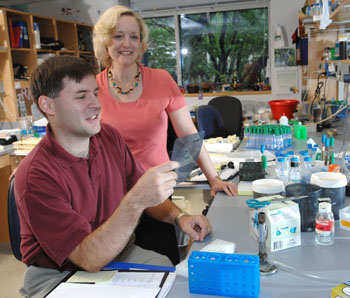
Susan Wente, Ph.D., and Timothy Bolger, Ph.D., examine a slide in Wente’s lab. (photo by Neil Brake)
Protein’s double life may hold clues to rare disorder
While the cell's nucleus houses the genetic code, much of the “action” — the translation of that genetic material into proteins that do the “work” of the cell — happens outside the nucleus, in the cytoplasm.
Vanderbilt Medical Center investigators now report that a protein that helps shuttle genetic material out of the cell's nucleus has a crucial new role in regulating gene expression.
This new, dual role for the protein Gle1, reported in the Aug. 22 issue of Cell, may offer surprising insight into a rare disorder that causes fetal death, said Susan Wente, Ph.D., professor and chair of Cell and Developmental Biology, and senior author on the paper.
Proteins made in the cytoplasm must move into the nucleus to transcribe, or copy, DNA into messenger RNA (mRNA). These mRNAs are then transported out of the nucleus into the cytoplasm where they are translated into proteins.
The spatial separation of transcription from translation allows for careful regulation of the genome and requires special machinery to selectively allow things to go in and out.
For more than a decade, Wente's lab has investigated the components of this transport machinery.
In 1996, they discovered Gle1 and identified it as an “export factor,” a protein that helps transport mRNA from the nucleus to the cytoplasm via an opening in the nuclear membrane, the nuclear pore complex.
In 1999, the team discovered that Gle1 got help from a small signaling molecule known as inositol hexakisphosphate (IP6).
Recently, they unraveled the molecular mechanism for Gle1/IP6 action at the nuclear pore complex. However, Wente's lab and others suspected that Gle1 and IP6 might also play important roles elsewhere in the cell.
“We had some preliminary evidence that these factors might be involved in a later step in the life cycle of mRNA, the translation step,” said Timothy Bolger, Ph.D., a postdoctoral fellow in Wente's lab and the lead author on the study.
Using yeast cells, Bolger investigated the interaction of Gle1 with proteins crucial for translation. The researchers generated mutant yeast that lacked either Gle1 or IP6, finding that both Gle1 and IP6 are required to stop the translation process at the appropriate point.
Gle1 also interacted with proteins that initiate translation. However, translation initiation required only Gle1 since yeast cells lacking IP6 had no defects in that step. They concluded that Gle1 is critical to multiple steps in translation.
Having multiple roles for Gle1 and IP6 in the life cycle of mRNA could be key to coordinating the steps of gene expression essential for cell physiology.
“If you regulate one (factor), you can change multiple steps at the same time. Turning off Gle1 would inhibit mRNA export, translation initiation and translation termination at the same time,” said Bolger.
“Coordinated regulation of gene expression is important for cellular responses to stimuli like growth conditions, cell cycle stage, disease states and development.”
Because the yeast and human proteins are similar, Wente suspects that “the human proteins are potentially doing the same things.”
But Gle1 is so critical to a cell's function that Wente predicted that mutations in it would result in global defects and not be linked to a specific human disease. Yet in February of this year, a study by researchers in Finland showed that mutations in GLE1 are linked to a condition called LCCS1 (lethal congenital contracture syndrome 1), a fetal motor neuron disease that leads to fetal death by 32 weeks of gestation.
Two related conditions (LCCS2 and LCCS3) are linked to enzymes in the inositol pathway to which IP6 belongs. So it is possible that this set of human conditions may be caused by a common biochemical defect in the pathways studied by Wente's lab.
Wente notes that with her group's basic science research efforts coupled with clinicians investigating genetic causes of disease, a clearer picture is starting to emerge about the human health importance of these factors.
“If we hadn't made our basic discoveries of Gle1 and IP6 function, (the Finnish group) would have mapped the disease locus to an uncharacterized gene encoding a protein of unknown function. They would have had to find the 'needle in the haystack' to unravel the defect," Wente said.
“Our years of basic science research allowed an instant understanding of the potential molecular mechanism underlying the disease.”
Other authors on the paper include Andrew Folkmann and Elizabeth Tran, Ph.D. The work was supported by grants from the National Institutes of Health.













